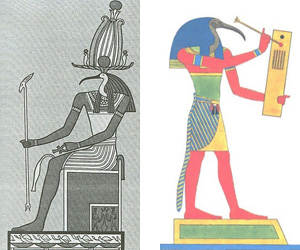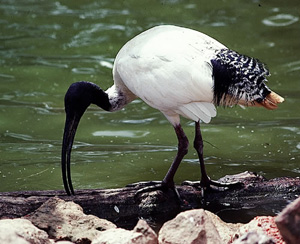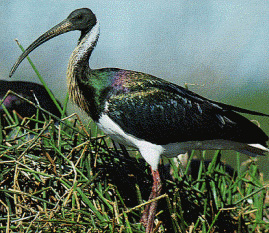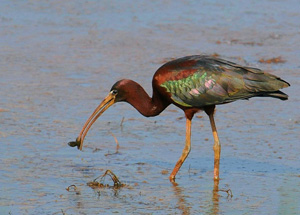Tom Parkinson's monthly column, introducing the diverse range of flora and fauna on show at Sanctuary Lakes.
During this month of May, all three Australian species of the Ibis can be seen in the Sanctuary Lakes Resort.
 The Deity Thoth part man part Ibis The Ibis is a very ancient species and was an intricate part of Egyptian mythology. Thoth, one of the most important deities of the Egyptian pantheon, was depicted as a man with the head of an ibis. Thoth's roles in Egyptian mythology were many. He served as a mediating power, especially between good and evil, making sure neither had a decisive victory over the other. He also served as scribe of the gods, credited with the invention of writing and alphabets (i.e. hieroglyphs) themselves. Without his words, the Egyptians believed, the gods would not exist.
The Deity Thoth part man part Ibis The Ibis is a very ancient species and was an intricate part of Egyptian mythology. Thoth, one of the most important deities of the Egyptian pantheon, was depicted as a man with the head of an ibis. Thoth's roles in Egyptian mythology were many. He served as a mediating power, especially between good and evil, making sure neither had a decisive victory over the other. He also served as scribe of the gods, credited with the invention of writing and alphabets (i.e. hieroglyphs) themselves. Without his words, the Egyptians believed, the gods would not exist.
The Egyptians credited him as the author of all works of science, religion, philosophy, and magic. The Greeks went further and declared him the inventor of astronomy, astrology, the science of numbers, mathematics, geometry, land surveying, medicine, botany, theology, civilized government, the alphabet, reading, writing, and oratory. They further claimed he was the true author of every work of every branch of knowledge, human and divine.
I must point out that when I look at the Ibis poking around the mud in search of a tasty worm I find it hard not to be a little cynical of the Egyptians' and Greeks' claims for the part Ibis God Thoth. But there again, even the Hebrews placed the Ibis in high esteem. According to biblical tradition, Moses used the Ibis to help him defeat the Ethiopians. Still today, an Ibis is the unit symbol of the Israeli Special Forces.
Sanctuary Lakes could be humbled that such birds cloaked with a phenomenal ancient history, have decided to make the Resort a resting and feeding place between summer breeding and northern wintering. This is due in the main to the twentieth first century climate, urban development and food conditions for not just one species but all three Australian Ibis - the White, the Straw Neck and the Glossy.
 The Australian White Ibis (Threskiornis moluccus)The Australian White Ibis is the largest of the three Australian Ibis (65cms to 70cms) and is easily identified by its almost entirely white body plumage and black head and neck. The head is featherless and its black bill is long and down-curved. During the breeding season the small patch of skin on the under-surface of the wing changes from dull pink to dark scarlet. Adult birds have a tuft of cream plumes on the base of the neck.
The Australian White Ibis (Threskiornis moluccus)The Australian White Ibis is the largest of the three Australian Ibis (65cms to 70cms) and is easily identified by its almost entirely white body plumage and black head and neck. The head is featherless and its black bill is long and down-curved. During the breeding season the small patch of skin on the under-surface of the wing changes from dull pink to dark scarlet. Adult birds have a tuft of cream plumes on the base of the neck.
The Australian White Ibis is widespread in eastern, northern and south-western Australia. Its preferred habitat are lagoons swamp and marsh lands but today they also occur in open spaces, parks and rubbish dumps within the city precincts. Historically it was rare to see a White Ibis in urban areas; the first influx was noted after drought drove birds eastwards in the late 1970s. The urban population further increased after a second period of drought in 1998. The increase has continued to the point where the traditional breeding grounds of Macquarie Wetlands (NSW) and Murray Basin (Vic/SA) are no longer used. Most dramatically in Macquarie Wetlands where there were over 2,000 breeding pairs at the turn of this century, but now fifteen years later there are but a handful. Yet there seems to be no lowering flock numbers. The White Ibis who are known for their nomadic behaviour are probably changing patterns and Sanctuary Lakes with its abundance of aquatic invertebrates, land worms and nearby Werribee Tip for human scraps, seems to have become a White Ibis favoured stopping place.
 Straw-necked Ibis (Threskiornis spinicollis)Slightly smaller than the White Ibis is the Straw-necked Ibis (Threskiornis spinicollis). They have dark wings that show an iridescent, multi-coloured sheen in sunlight, and have a dark back and collar. Most of the neck is white, as are the underparts and under tail. They have a long, black, down curved bill and their legs are usually red near the top and dark grey toward the feet. Straw-like feathers on the neck give it its common name. Its other common name is Farmer's Friend, coming from its insatiable appetite for grassland insects such as grasshoppers and locusts. The Straw-necked Ibis prefers wet and dry grasslands, swamp or lagoon margins where it enjoys frogs and aquatic reptiles. It is highly nomadic constantly searching for suitable habitat and food conditions. The longest recorded movement of a Straw-necked Ibis was from Muchea in south-western WA to Beaudesert in south-eastern Queensland, a distance of well over 3,500 kilometres. Unlike the White Ibis it is not an opportunist scavenger, rarely entering central cities and certainly not a visitor to rubbish tips.
Straw-necked Ibis (Threskiornis spinicollis)Slightly smaller than the White Ibis is the Straw-necked Ibis (Threskiornis spinicollis). They have dark wings that show an iridescent, multi-coloured sheen in sunlight, and have a dark back and collar. Most of the neck is white, as are the underparts and under tail. They have a long, black, down curved bill and their legs are usually red near the top and dark grey toward the feet. Straw-like feathers on the neck give it its common name. Its other common name is Farmer's Friend, coming from its insatiable appetite for grassland insects such as grasshoppers and locusts. The Straw-necked Ibis prefers wet and dry grasslands, swamp or lagoon margins where it enjoys frogs and aquatic reptiles. It is highly nomadic constantly searching for suitable habitat and food conditions. The longest recorded movement of a Straw-necked Ibis was from Muchea in south-western WA to Beaudesert in south-eastern Queensland, a distance of well over 3,500 kilometres. Unlike the White Ibis it is not an opportunist scavenger, rarely entering central cities and certainly not a visitor to rubbish tips.
The Straw-necked Ibis forms large breeding colonies close to marshland, lagoons or ponds. The low nests are large trampled platforms of reeds, rushes and sticks over water, often blending together to form one continuous platform, and are re-used over many years. Normally they lay 3-5 dull, lime-white eggs. Incubation is for 20-25 days. Chicks swim after three weeks and flying within five. They are fully mature at about two years old.
 Glossy Ibis (Plegadis falcinellus)The smallest of the Australian Ibises is the Glossy Ibis (Plegadis falcinellus). A small dark Ibis (50-55cm) that looks black in the distance. At close quarters, the neck is reddish-brown and the body is a bronze-brown with a metallic iridescent sheen on the wings. The distinctive long, curved bill is olive-brown, the facial skin is blue-grey with a bordering white line that extends around the eyes. The eyes, legs and feet are brown. Unlike other species of ibis in Australia, the Glossy Ibis is unlikely to be seen foraging in rubbish tips or on farmland, instead preferring to probe the mud of shallow terrestrial wetlands in pursuit of aquatic invertebrates, frogs, and small snakes. They are nomadic but with set migratory routes, it unusual but not rare for them to visit the SW Victoria. For the southern Glossy Ibis, the main breeding areas are the Murray Darling Basin.
Glossy Ibis (Plegadis falcinellus)The smallest of the Australian Ibises is the Glossy Ibis (Plegadis falcinellus). A small dark Ibis (50-55cm) that looks black in the distance. At close quarters, the neck is reddish-brown and the body is a bronze-brown with a metallic iridescent sheen on the wings. The distinctive long, curved bill is olive-brown, the facial skin is blue-grey with a bordering white line that extends around the eyes. The eyes, legs and feet are brown. Unlike other species of ibis in Australia, the Glossy Ibis is unlikely to be seen foraging in rubbish tips or on farmland, instead preferring to probe the mud of shallow terrestrial wetlands in pursuit of aquatic invertebrates, frogs, and small snakes. They are nomadic but with set migratory routes, it unusual but not rare for them to visit the SW Victoria. For the southern Glossy Ibis, the main breeding areas are the Murray Darling Basin.
Glossy Ibises nest in small colonies of 10-20 pairs; they may breed within colonies of Straw-necked Ibises and White Ibises. They start breeding later than the other Ibises, September - April and build their nests sometimes lower or just above the water. A nest platform is built of sticks and lined with aquatic plant material. The common nest site is between upright branches of bushes or tree growing in water with four to six eggs, with incubation up to 21 days and fledgling to another 21 days.
Australia is one of the driest continents on earth and many native waterbirds, like the Ibis, travel great distances in search of suitable freshwater wetlands and estuaries. Ibis respond to the cycles of climate by adapting and breeding when conditions are right and are known to be heavily reliant upon flood waters of inland rivers. The recent years of more volatile weather patterns, multitude of big and small Bush Fires and dramatic rainfalls have affected the Ibis' normal breeding feeding migratory routes and timetables. Sanctuary Lakes and its environs could well suit the Ibis' needs prior to their flight north and their winter feeding bases. Let's hope that the late April, May stopover becomes a regular appointment for all three of the Australian Ibis Family. After all if the Egyptian and Greek legends are to be believed, the Ibis God Thoth comes with a CV that could be very handy for mediating the ups and downs of the Resort and Golf Club.